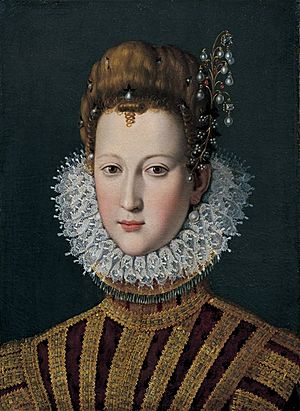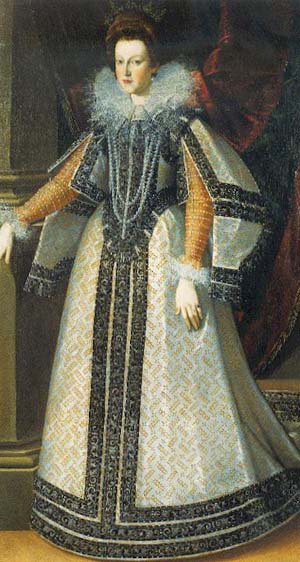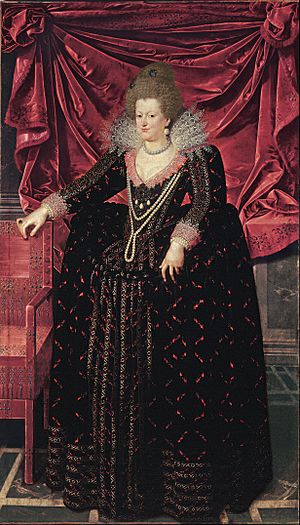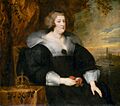Marie de' Medici facts for kids
Quick facts for kids Marie de Medici |
|
|---|---|

Portrait by Frans Pourbus the Younger
|
|
| Queen consort of France and Navarre | |
| Tenure | 17 December 1600 – 14 May 1610 |
| Coronation | 13 May 1610 |
| Regent of France | |
| Regency | 14 May 1610 – 2 October 1614 |
| Monarch | Louis XIII |
| Born | 26 April 1575 Palazzo Pitti, Florence, Tuscany |
| Died | 3 July 1642 (aged 67) Cologne, Holy Roman Empire |
| Burial | Basilica of St Denis, Paris, France |
| Spouse | |
| Issue |
|
| House | Medici |
| Father | Francesco I, Grand Duke of Tuscany |
| Mother | Joanna of Austria |
| Religion | Roman Catholicism |
| Signature |  |
Marie de' Medici (born April 26, 1575 – died July 3, 1642) was a powerful queen in French history. She was the second wife of King Henry IV of France. This made her the Queen of France and Navarre.
After her husband died in 1610, Marie became the regent for her young son, Louis XIII of France. A regent is someone who rules a country when the king or queen is too young. She was officially regent until 1614. However, she kept a lot of power until 1617, when her son took full control.
Marie was known for her love of art and for supporting many artists. She also had a strong influence on French politics. She was eventually sent away from France by her own son. She died in Cologne, Germany.
Contents
Life Story of Marie de' Medici
Early Years and Family Life
Marie de' Medici was born in Florence, Italy, on April 26, 1575. Her family, the Medici, was very rich and powerful. Her father was Francesco I de' Medici, the Grand Duke of Tuscany. Her mother was Joanna of Austria.
Marie had several brothers and sisters, but only two sisters lived past childhood. Her only brother, Philip, died when he was four. Marie and her older sister, Eleonora, grew up in the Palazzo Pitti in Florence. They were very close.
After Eleonora married and moved away, Marie became close to a girl named Leonora Dori. Leonora was a few years older and became Marie's trusted friend. Marie often asked Leonora for advice before making decisions.
When Marie was 12, both her parents died. Her uncle, Ferdinando I de' Medici, became the new Grand Duke. He made sure Marie received a good education. She enjoyed learning about math, philosophy, and astronomy. She also loved art, jewelry, and music. Marie was known for being very religious and for relying on her friends for support.
Because of her family's wealth, many important men wanted to marry Marie. The most famous suitor was King Henry IV of France.
Becoming Queen of France
King Henry IV of France needed money and an heir to his throne. Marie de' Medici's family was very rich. They also promised a huge dowry (money or property brought by a bride to her husband). This dowry helped Henry IV pay off his debts. Some people even called Marie "the big banker" because of her wealth.
Henry IV had ended his first marriage. So, he began talks to marry Marie. The wedding agreement was signed in Paris in March 1600. The marriage ceremony happened in Florence on October 5, 1600. Marie then traveled to France. She met Henry IV on December 9, and they had their religious wedding on December 17.
Marie gave birth to her first child, a son named Louis, on September 27, 1601. This was a very happy event for France, as Louis was the heir to the throne. Marie had five more children with Henry IV.
Their marriage was not always happy. Marie was often jealous because Henry IV had many other relationships. She also argued with him about money for her royal household. Marie really wanted to be officially crowned Queen of France. Henry IV kept delaying the ceremony.

Finally, Marie was crowned Queen of France on May 13, 1610. This was important because Henry IV was about to go to war. The coronation would give Marie more power if she had to rule while he was away. The very next day, May 14, Henry IV was killed. This sudden death led to many rumors of a plot.
Marie as Regent
Hours after Henry IV's death, Marie was named Regent for her eight-year-old son, Louis XIII. She quickly sent away her late husband's mistress. At first, she kept Henry IV's old advisors.
Marie was seen as a foreigner by many in France. She also relied heavily on her Italian friends, especially Leonora Dori and her husband, Concino Concini. Concini gained a lot of power and wealth, which made many French nobles angry.
Marie kept her late husband's policy of religious tolerance. She confirmed the Edict of Nantes, which allowed Protestants to practice their religion in France.
Marie also changed France's foreign policy. She made an alliance with Habsburg Spain. In 1615, her daughter Elisabeth married the future King Philip IV of Spain. Her son Louis XIII married Anne of Austria, Philip IV's sister.
However, many French nobles were unhappy with Marie's rule. They didn't like her Italian friends gaining so much power. They also worried about her alliance with Spain. Some nobles, led by Henri II, Prince of Condé, rebelled against Marie.
Marie called a meeting of the Estates General in Paris in 1614. This was a meeting of representatives from different groups in France. The nobles and common people argued, which helped Marie keep control. Louis XIII officially became an adult in October 1614. But Marie still led the King's Council and kept her power.
In 1616, Marie had the Prince of Condé arrested. She also appointed a new minister, Armand Jean du Plessis, who later became famous as Cardinal Richelieu.
Louis XIII, though an adult, felt his mother had too much power. In April 1617, he organized a plan to take control. Concino Concini was killed, and Marie was sent away to the Château de Blois.
Escape and Return
In February 1619, Marie, then 43, escaped from her prison at the Château de Blois using a rope ladder. She found safety in another castle and started a rebellion against her son, Louis XIII. This was called the "war of mother and son."
Cardinal Richelieu helped to calm the conflict. A peace treaty was signed. But Marie was not satisfied and started another war. Louis XIII quickly defeated her forces. He then forgave his mother and the nobles who had joined her.
Louis XIII realized he needed his mother closer to avoid more plots. So, he allowed her to return to court in Paris. Marie then began building her famous Luxembourg Palace. After a few years, she slowly regained her political influence. Richelieu helped her get back into the King's Council.
Supporting the Arts
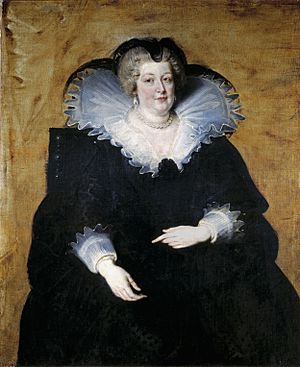
Marie de' Medici loved art and supported many artists. She hired painters and sculptors to decorate her palaces. For her apartments at the Palace of Fontainebleau, she had paintings made about myths and stories. At the Louvre, she had new apartments decorated with beautiful artworks.
She also supported portrait painters, like Frans Pourbus the Younger.
Marie played a huge part in developing art in Paris. She focused on building and furnishing the Luxembourg Palace. She called it her "Palais Médicis." Construction began in 1615. She invited famous artists to Paris, including the Flemish painter Peter Paul Rubens. Rubens created a famous series of 21 large paintings about Marie's life and reign. This series, called the "Marie de' Medici cycle," is now in the Louvre Museum.
Final Years and Death
Marie continued to be part of the King's Council, often following Richelieu's advice. She had even introduced Richelieu to her son, the King. However, she didn't realize how powerful Richelieu was becoming. When she did, she tried to remove him from power.
In November 1630, after a day known as the "Day of the Dupes," Richelieu remained the King's main minister. Marie was forced to make peace with him.
Marie decided to leave the court. Louis XIII, who felt his mother was too involved in plots, encouraged her to retire. In July 1631, she fled France and went to Brussels. She hoped to gain support there, but her escape was a trap set by her son. She lost her royal payments and became a refugee.
Marie traveled to different courts in Europe. She visited her daughter, Queen Henrietta Maria, in England for three years. She also went to Germany. She tried to form alliances against France, but she was never able to return home. Her supporters were often imprisoned or exiled.
She visited Amsterdam, which was a big diplomatic success for the Dutch. They gave her a grand welcome.
Marie eventually went to Cologne, Germany. She stayed in a house loaned by her friend, the artist Peter Paul Rubens. She became ill in June 1642 and died on July 3, 1642. She died just a few months before Richelieu. Her body was brought back to France and buried in the Basilica of St Denis.
Children of Marie de' Medici
| Name | Birth | Death | Notes |
|---|---|---|---|
| Louis XIII, King of France | 27 September 1601 | 14 May 1643 | Married Anne of Austria in 1615. They had two sons who lived to be adults. |
| Elisabeth, Queen of Spain | 22 November 1602 | 6 October 1644 | Married Philip IV, King of Spain in 1615. They had one son and one daughter who lived to be adults. |
| Christine, Duchess of Savoy | 10 February 1606 | 27 December 1663 | Married Victor Amadeus I, Duke of Savoy in 1619. They had one son and three daughters who lived to be adults. |
| Son, Duke of Orléans | 16 April 1607 | 17 November 1611 | Died young. |
| Gaston, Duke of Orléans | 25 April 1608 | 2 February 1660 | Married twice. Had one daughter from his first marriage and three daughters from his second marriage who lived to be adults. |
| Henrietta Maria, Queen of England | 25 November 1609 | 10 September 1669 | Married Charles I, King of England in 1625. They had three sons and two daughters who lived to be adults. |
Images for kids
-
The exiled Queen Marie de Médicis with coronet overlooking Cologne, by Anthony van Dyck.
See also
 In Spanish: María de Médici para niños
In Spanish: María de Médici para niños



